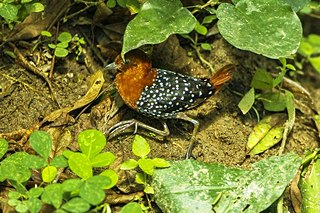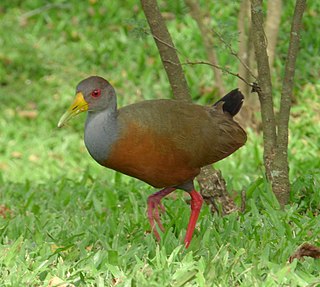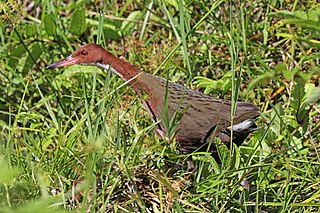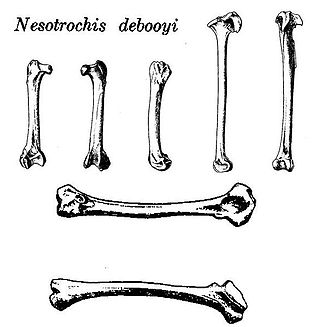
The Gruiformes are an order containing a considerable number of living and extinct bird families, with a widespread geographical diversity. Gruiform means "crane-like".

Rails are a large, cosmopolitan family of small- to medium-sized terrestrial and/or semi-amphibious birds. The family exhibits considerable diversity in its forms, and includes such ubiquitous species as the crakes, coots, and gallinule; other rail species are extremely rare or endangered. Many are associated with wetland habitats, some being semi-aquatic like waterfowl, but many more are wading birds or shorebirds. The ideal rail habitats are marsh areas, including rice paddies, and flooded fields or open forest. They are especially fond of dense vegetation for nesting. The rail family is found in every terrestrial habitat with the exception of dry desert, polar or freezing regions, and alpine areas. Members of Rallidae occur on every continent except Antarctica. Numerous unique island species are known.

The adzebills, genus Aptornis, were two closely related bird species, the North Island adzebill,, and the South Island adzebill,, of the extinct family Aptornithidae. The family was endemic to New Zealand. A tentative fossil species,, is known from the Miocene Saint Bathans fauna.

The Tahiti rail, Tahitian red-billed rail, or Pacific red-billed rail is an extinct species of rail that lived on Tahiti. It was first recorded during James Cook's second voyage around the world (1772–1775), on which it was illustrated by Georg Forster and described by Johann Reinhold Forster. No specimens have been preserved. As well as the documentation by the Forsters, there have been claims that the bird also existed on the nearby island of Mehetia. The Tahiti rail appears to have been closely related to, and perhaps derived from, the buff-banded rail, and has also been historically confused with the Tongan subspecies of that bird.

Flufftails are small birds related to rails and finfoots. There are nine species, seven of which are distributed across sub-Saharan Africa, with the remaining two in Madagascar. The genus was long placed with the rail family Rallidae, but is now placed in the family Sarothruridae, along with three other species of wood rails.

The genus Dryolimnas comprises birds in the rail family. The Réunion rail, a member of this genus, became extinct in the 17th century. The white-throated rail of Aldabra is the last surviving flightless bird in the western Indian Ocean. They are mostly found on Malabar Island, but can also be found on Polymnieli Island and other islands.

Laterallus is a genus of birds in the rail family Rallidae. These small, relatively short-billed terrestrial rails are found among dense vegetation near water in the Neotropics, although a single species, the black rail, also occurs in the United States.

The grey-cowled wood rail or grey-necked wood rail is a species of bird in the family Rallidae, the rails. It lives primarily in the forests, mangroves, and swamps of Central and South America. Of the two subspecies, A. c. avicenniae is found in southeastern Brazil, while the nominate is found throughout the portion of the range not occupied by the other subspecies. The species as a whole is usually found at elevations from sea level to 2,000 metres (6,600 ft), although some have been found above that. This bird's large extent of occurrence along with its population is why it is considered to be least-concern by the International Union for Conservation of Nature (IUCN). In some places, it is occasionally hunted and kept for food.

The Madagascar forest rail, also known as the Madagascar wood rail or the kioloides rail, is a species of bird in the family Sarothruridae. It is endemic to forests, often in wet areas, in northern and eastern Madagascar. The Madagascar forest rail is a secretive and shy species, often showing elusive behavior, such as running away from the slightest disturbances. This has contributed to a lack of study on this species; a reason why it is not that well known.

The grey-throated rail is a species of bird in the family Rallidae, the only member of the genus Canirallus. It is found in Cameroon, Central African Republic, Republic of the Congo, Democratic Republic of the Congo, Ivory Coast, Equatorial Guinea, Gabon, Ghana, Guinea, Liberia, Nigeria, and Sierra Leone.

The white-throated rail or Cuvier's rail, is a species of bird in the family Rallidae.

The yellow-bellied flyrobin is a species of passerine bird in the Australasian robin family Petroicidae. It is the only species in the genus Cryptomicroeca. The yellow-bellied flyrobin is endemic to New Caledonia, where it occurs on the island of Grande Terre. It occupies a range of habitats, including dry lowlands, woodland, Pinus and Pandanus forest, and humid forest from sea level up to 1,525 m (5,000 ft).

The star-throated antwren is an insectivorous bird in the antbird family Thamnophilidae. It is endemic to the Atlantic Forest region of southeast Brazil. Its natural habitats are subtropical or tropical moist lowland forest and subtropical or tropical moist montane forest.

Sarothruridae is a family of small- to medium-sized ground-living birds found mostly in Madagascar and sub-Saharan Africa, with the genus Rallicula being restricted to New Guinea and the Moluccas. The species in this family were once considered to sit with the larger rail family Rallidae.

Mentocrex is a genus of birds in the flufftail family, Sarothruridae. The genus includes two species, both of which are endemic to forests in Madagascar.

Eurypygiformes is an order formed by the kagus, comprising two species in the family Rhynochetidae endemic to New Caledonia, and the sunbittern from the tropical regions of the Americas. Its closest relatives appear to be the tropicbirds of the tropical Atlantic, Indian, and Pacific oceans.

Nesotrochis is a genus of extinct flightless birds that were endemic to the islands of the Greater Antilles in the Caribbean. They have often been called cave rails, though they are no longer considered true rails, but an independent lineage of gruiform birds.
Velizar Simeonovski is a wildlife artist and zoologist from Bulgaria who is living and working in the United States. His main interest is the paleoart, the scientific illustration and artistic reconstruction of extinct species and the visualization of primeval landscapes. Simeonovski uses computer programs to create his drawings. He is married and has two sons. Since 2003, he works for the Field Museum of Natural History in Chicago, Illinois.
















